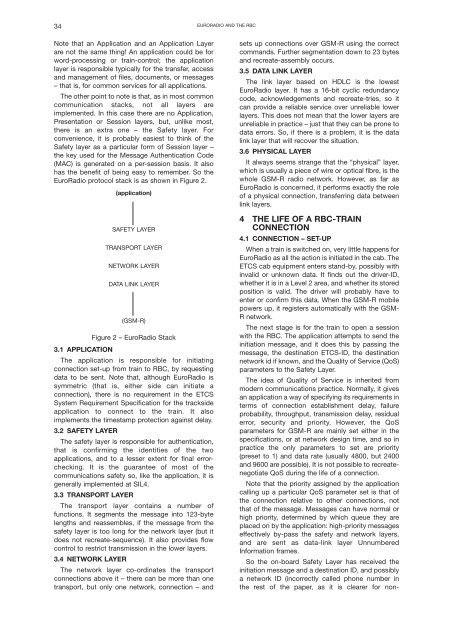Proceedings 2002/2003 - IRSE
Proceedings 2002/2003 - IRSE
Proceedings 2002/2003 - IRSE
You also want an ePaper? Increase the reach of your titles
YUMPU automatically turns print PDFs into web optimized ePapers that Google loves.
34<br />
EURORADIO AND THE RBC<br />
Note that an Application and an Application Layer<br />
are not the same thing! An application could be for<br />
word-processing or train-control; the application<br />
layer is responsible typically for the transfer, access<br />
and management of files, documents, or messages<br />
– that is, for common services for all applications.<br />
The other point to note is that, as in most common<br />
communication stacks, not all layers are<br />
implemented. In this case there are no Application,<br />
Presentation or Session layers, but, unlike most,<br />
there is an extra one – the Safety layer. For<br />
convenience, it is probably easiest to think of the<br />
Safety layer as a particular form of Session layer –<br />
the key used for the Message Authentication Code<br />
(MAC) is generated on a per-session basis. It also<br />
has the benefit of being easy to remember. So the<br />
EuroRadio protocol stack is as shown in Figure 2.<br />
(application)<br />
SAFETY LAYER<br />
TRANSPORT LAYER<br />
NETWORK LAYER<br />
DATA LINK LAYER<br />
(GSM-R)<br />
Figure 2 – EuroRadio Stack<br />
3.1 APPLICATION<br />
The application is responsible for initiating<br />
connection set-up from train to RBC, by requesting<br />
data to be sent. Note that, although EuroRadio is<br />
symmetric (that is, either side can initiate a<br />
connection), there is no requirement in the ETCS<br />
System Requirement Specification for the trackside<br />
application to connect to the train. It also<br />
implements the timestamp protection against delay.<br />
3.2 SAFETY LAYER<br />
The safety layer is responsible for authentication,<br />
that is confirming the identities of the two<br />
applications, and to a lesser extent for final errorchecking.<br />
It is the guarantee of most of the<br />
communications safety so, like the application, it is<br />
generally implemented at SIL4.<br />
3.3 TRANSPORT LAYER<br />
The transport layer contains a number of<br />
functions. It segments the message into 123-byte<br />
lengths and reassembles, if the message from the<br />
safety layer is too long for the network layer (but it<br />
does not recreate-sequence). It also provides flow<br />
control to restrict transmission in the lower layers.<br />
3.4 NETWORK LAYER<br />
The network layer co-ordinates the transport<br />
connections above it – there can be more than one<br />
transport, but only one network, connection – and<br />
sets up connections over GSM-R using the correct<br />
commands. Further segmentation down to 23 bytes<br />
and recreate-assembly occurs.<br />
3.5 DATA LINK LAYER<br />
The link layer based on HDLC is the lowest<br />
EuroRadio layer. It has a 16-bit cyclic redundancy<br />
code, acknowledgements and recreate-tries, so it<br />
can provide a reliable service over unreliable lower<br />
layers. This does not mean that the lower layers are<br />
unreliable in practice – just that they can be prone to<br />
data errors. So, if there is a problem, it is the data<br />
link layer that will recover the situation.<br />
3.6 PHYSICAL LAYER<br />
It always seems strange that the “physical” layer,<br />
which is usually a piece of wire or optical fibre, is the<br />
whole GSM-R radio network. However, as far as<br />
EuroRadio is concerned, it performs exactly the role<br />
of a physical connection, transferring data between<br />
link layers.<br />
4 THE LIFE OF A RBC-TRAIN<br />
CONNECTION<br />
4.1 CONNECTION – SET-UP<br />
When a train is switched on, very little happens for<br />
EuroRadio as all the action is initiated in the cab. The<br />
ETCS cab equipment enters stand-by, possibly with<br />
invalid or unknown data. It finds out the driver-ID,<br />
whether it is in a Level 2 area, and whether its stored<br />
position is valid. The driver will probably have to<br />
enter or confirm this data. When the GSM-R mobile<br />
powers up, it registers automatically with the GSM-<br />
R network.<br />
The next stage is for the train to open a session<br />
with the RBC. The application attempts to send the<br />
initiation message, and it does this by passing the<br />
message, the destination ETCS-ID, the destination<br />
network id if known, and the Quality of Service (QoS)<br />
parameters to the Safety Layer.<br />
The idea of Quality of Service is inherited from<br />
modern communications practice. Normally, it gives<br />
an application a way of specifying its requirements in<br />
terms of connection establishment delay, failure<br />
probability, throughput, transmission delay, residual<br />
error, security and priority. However, the QoS<br />
parameters for GSM-R are mainly set either in the<br />
specifications, or at network design time, and so in<br />
practice the only parameters to set are priority<br />
(preset to 1) and data rate (usually 4800, but 2400<br />
and 9600 are possible). It is not possible to recreatenegotiate<br />
QoS during the life of a connection.<br />
Note that the priority assigned by the application<br />
calling up a particular QoS parameter set is that of<br />
the connection relative to other connections, not<br />
that of the message. Messages can have normal or<br />
high priority, determined by which queue they are<br />
placed on by the application: high-priority messages<br />
effectively by-pass the safety and network layers,<br />
and are sent as data-link layer Unnumbered<br />
Information frames.<br />
So the on-board Safety Layer has received the<br />
initiation message and a destination ID, and possibly<br />
a network ID (incorrectly called phone number in<br />
the rest of the paper, as it is clearer for non-

















